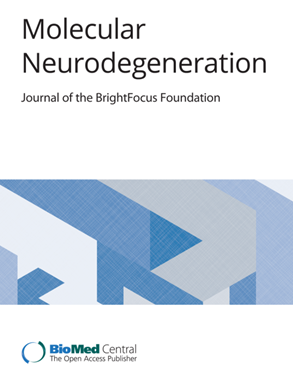Molecular hallmarks of excitatory and inhibitory neuronal resilience to Alzheimer’s disease
IF 17.5
1区 医学
Q1 NEUROSCIENCES
引用次数: 0
Abstract
A significant proportion of individuals maintain cognition despite extensive Alzheimer’s disease (AD) pathology, known as cognitive resilience. Understanding the molecular mechanisms that protect these individuals could reveal therapeutic targets for AD. This study defines molecular and cellular signatures of cognitive resilience by integrating bulk RNA and single-cell transcriptomic data with genetics across multiple brain regions. We analyzed data from the Religious Order Study and the Rush Memory and Aging Project (ROSMAP), including bulk RNA sequencing (n = 631 individuals) and multiregional single-nucleus RNA sequencing (n = 48 individuals). Subjects were categorized into AD, resilient, and control based on β-amyloid and tau pathology, and cognitive status. We identified and prioritized protected cell populations using whole-genome sequencing-derived genetic variants, transcriptomic profiling, and cellular composition. Transcriptomics and polygenic risk analysis position resilience as an intermediate AD state. Only GFAP and KLF4 expression distinguished resilience from controls at tissue level, whereas differential expression of genes involved in nucleic acid metabolism and signaling differentiated AD and resilient brains. At the cellular level, resilience was characterized by broad downregulation of LINGO1 expression and reorganization of chaperone pathways, specifically downregulation of Hsp90 and upregulation of Hsp40, Hsp70, and Hsp110 families in excitatory neurons. MEF2C, ATP8B1, and RELN emerged as key markers of resilient neurons. Excitatory neuronal subtypes in the entorhinal cortex (ATP8B+ and MEF2Chigh) exhibited unique resilience signaling through activation of neurotrophin (BDNF-NTRK2, modulated by LINGO1) and angiopoietin (ANGPT2-TEK) pathways. MEF2C+ inhibitory neurons were over-represented in resilient brains, and the expression of genes associated with rare genetic variants revealed vulnerable somatostatin (SST) cortical interneurons that survive in AD resilience. The maintenance of excitatory-inhibitory balance emerges as a key characteristic of resilience. We have defined molecular and cellular hallmarks of cognitive resilience, an intermediate state in the AD continuum. Resilience mechanisms include preserved neuronal function, balanced network activity, and activation of neurotrophic survival signaling. Specific excitatory neuronal populations appear to play a central role in mediating cognitive resilience, while a subset of vulnerable interneurons likely provides compensation against AD-associated hyperexcitability. This study offers a framework to leverage natural protective mechanisms to mitigate neurodegeneration and preserve cognition in AD.兴奋性和抑制性神经元抗阿尔茨海默病的分子特征
尽管有广泛的阿尔茨海默病(AD)病理,但很大比例的个体保持认知,称为认知弹性。了解保护这些个体的分子机制可以揭示AD的治疗靶点。本研究通过整合大量RNA和单细胞转录组数据以及跨多个大脑区域的遗传学,定义了认知弹性的分子和细胞特征。我们分析了来自宗教秩序研究和拉什记忆和衰老项目(ROSMAP)的数据,包括大量RNA测序(n = 631个个体)和多区域单核RNA测序(n = 48个个体)。根据β-淀粉样蛋白和tau蛋白病理以及认知状态,将受试者分为AD、弹性和对照组。我们使用全基因组测序衍生的遗传变异、转录组分析和细胞组成来鉴定和优先考虑受保护的细胞群。转录组学和多基因风险分析将恢复力定位为AD的中间状态。只有GFAP和KLF4的表达在组织水平上区分了AD和弹性脑,而参与核酸代谢和信号传导的基因的差异表达区分了AD和弹性脑。在细胞水平上,恢复力的特征是广泛下调LINGO1表达和伴侣通路重组,特别是在兴奋性神经元中下调Hsp90和上调Hsp40、Hsp70和Hsp110家族。MEF2C、ATP8B1和RELN是弹性神经元的关键标志物。内嗅皮层的兴奋性神经元亚型(ATP8B+和mef2high)通过激活神经营养因子(由LINGO1调节的BDNF-NTRK2)和血管生成素(ANGPT2-TEK)通路表现出独特的弹性信号。MEF2C+抑制性神经元在恢复大脑中被过度代表,与罕见遗传变异相关的基因表达揭示了脆弱的生长抑素(SST)皮质中间神经元在AD恢复中存活。兴奋-抑制平衡的维持是恢复力的一个关键特征。我们已经定义了认知弹性的分子和细胞特征,认知弹性是AD连续体中的一种中间状态。恢复机制包括保存神经元功能、平衡网络活动和激活神经营养生存信号。特定的兴奋性神经元群似乎在调节认知弹性中发挥核心作用,而脆弱的中间神经元子集可能对ad相关的高兴奋性提供补偿。本研究提供了一个框架,利用自然保护机制来减轻AD患者的神经变性和保持认知。
本文章由计算机程序翻译,如有差异,请以英文原文为准。
求助全文
约1分钟内获得全文
求助全文
来源期刊

Molecular Neurodegeneration
医学-神经科学
CiteScore
23.00
自引率
4.60%
发文量
78
审稿时长
6-12 weeks
期刊介绍:
Molecular Neurodegeneration, an open-access, peer-reviewed journal, comprehensively covers neurodegeneration research at the molecular and cellular levels.
Neurodegenerative diseases, such as Alzheimer's, Parkinson's, Huntington's, and prion diseases, fall under its purview. These disorders, often linked to advanced aging and characterized by varying degrees of dementia, pose a significant public health concern with the growing aging population. Recent strides in understanding the molecular and cellular mechanisms of these neurodegenerative disorders offer valuable insights into their pathogenesis.
 求助内容:
求助内容: 应助结果提醒方式:
应助结果提醒方式:


